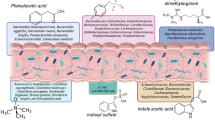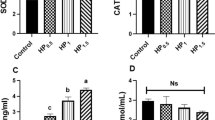Abstract
This review summarizes the main toxic effect of ochratoxin A (OTA) on liver metabolism. This contaminant is a mycotoxin that can be found in raw materials (cereals, coffee, cocoa, spices or grapewine), in processed foods (bread and other bakery products) and, if animals are fed with contaminated feedstuffs, in pork meat. Kidney is a well-known target of OTA, although several findings suggest that liver metabolism can be affected too. OTA intake reduces, in a dose-dependent manner, the synthesis of albumin, while the concomitant increase in transaminases (ALT, ASP) and alkaline phosphatase is in agreement with the hypothesis of liver damage induced by OTA. Feeding animals with OTA-contaminated feeds has significant pro-oxidative effects that cause a reduction in anti-oxidative defences and an increase in malondialdehyde formation. Experiments on human liver cells support the hypothesis of an inflammatory effect of OTA mediated by TNF-α. An up-regulation of apoptosis has also been detected in hepatic cells after OTA treatment, which leads to a higher rate of cell death and to a reduction of liver activity. All these findings suggest that OTA can have a toxic effect on the liver too and for this reason we should pay attention to liver toxicity of OTA in the risk assessment for this mycotoxin.

Similar content being viewed by others
Abbreviations
- ALP:
-
Alkaline phosphatase
- ALT:
-
Aspartate aminotransferase
- AST:
-
Aspartate transaminase
- BEN:
-
Balkan endemic nephropathy
- CAT:
-
Catalase
- DCF:
-
2,7-Dichlorofluorescein diacetate
- IARC:
-
The International Agency for Research on Cancer
- GGT:
-
γ-Glutamil transferase
- GPx:
-
Glutathione peroxidase
- GR:
-
Glutathione reductase
- GSH:
-
Glutathione
- MDA:
-
Malondialdehyde
- SOD:
-
Superoxide dismutase
- UTT:
-
Urinary tract tumours
References
Battilani P, Pietri A, Bertuzzi T, Languasco L, Giorni P, Kozakiewicz Z (2003) Occurrence of ochratoxin A producing fungi in grape grown in Italy. J Food Prot 66:633–636
O’Brien E, Dietrich DR (2005) Ochratoxin A: the continuing enigma. Crit Rev Toxicol 35:33–60
Jørgensen K (2005) Occurrence of ochratoxin A in commodities and processed food—a review of EU occurrence data. Food Add Contam 22(suppl 1):26–30
Studer-Rohr I, Schalatter J, Dietrich DR (2000) Kinetic parameters and intraindividual fluctuations of ochratoxin A in plasma levels in humans. Arch Toxicol 74:499–510
Biasucci G, Calabrese G, Di Giuseppe R, Carrara G, Colombo F, Mandelli B, Maj M, Bertuzzi T, Pietri A, Rossi F (2010) The presence of ochratoxin A in cord serum and in human milk and its correspondence with maternal dietary habits. Eur J Nutr 50:211–218
Galvano F, Ritieni A, Piva G, Pietri A (2005) Mycotoxins in the human food chain. In: Duarte-Diaz DE (ed) The mycotoxin blue book. Nottingham University Press, Nottingham, pp 187–224
Pfohl-Leszkowicz A, Manderville RA (2007) Ochratoxin A: an overview on toxicity and carcinogenicity in animals and humans. Mol Nutr Food Res 51:61–99
FAO/WHO, Food and Agriculture Organisation/World Health Organisation (2001) Ochratoxin A. In: Safety evaluation of certain mycotoxins in food, Prepared by the 56th Meeting of the Joint FAO/WHO Expert Committee on Food Additives (JECFA). WHO Food Additives Series 47. World Health Organisation, Geneva, Switzerland, pp 281–387
IARC (1993) IARC Monographs on the evaluation of carcinogenic risks to humans, some naturally occurring substances, Food Items and constituents, Heterocyclic aromatic amines and mycotoxins, vol 56. IARC Publications, Lyon
EFSA, European Food Safety Authority (2006) Opinion of the Scientific Panel on contaminants in the food chain on a request from the Commission related to ochratoxin A in food. EFSA J 365:1–56
di Giuseppe R, Bertuzzi T, Rossi F, Rastelli S, Mulazzi A, Capraro J, de Curtis A, Iacoviello L, Pietri A (2011) Plasma ochratoxin A levels, food consumption and risk biomarkers of a representative sample of men and women from the Molise region in Italy. Eur J Nutr. doi:10.1007/s00394-011-0265-5 (published on line)
Mally A, Völkel W, Amberg A, Kurz M, Wanek P, Eder E, Hard G, Dekant W (2005) Functional, biochemical, and pathological effects of repeated oral administration of ochratoxin A to rats. Chem Res Toxicol 18:1242–1252
Gagliano N, Dalle Donne I, Torri C, Migliori M, Grizzi F, Milzani A, Filippi C, Annoni G, Colombo G, Costa F, Ceva-Grimaldi G, Bertelli A, Giovannini L, Gioia M (2006) Early cytotoxic effects of ochratoxin A in rat liver: a morphological, biochemical and molecular study. Toxicology 225:214–224
Barbin A, Ohgaki H, Nakamura J, Kurrer M, Kleihues P, Swenberg JA (2003) Endogenous deoxyribonucleic acid (DNA) damage in human tissues: a comparison of ethenobases with aldehydic DNA lesions. Cancer Epi Biomark Prev 12:1241–1247
Packer JE (1995) Oxidative stress, antioxidants, aging and disease. In: Gulter RG, Packer LB, Eratum J, Mori A (eds) Oxidative stress and aging. Birkhäuser, Basel
Meki Abdel-Raheim MA, Hussein Amed AA (2001) Melatonin reduces oxidative stress induced by ochratoxin A in rat liver and kidney. Comp Biochem Physiol Part C 130:305–313
Chakraborty D, Verma R (2010) Ameliorative effect of Emblica officinalis aqueous extract on ochratoxin-induced lipid peroxidation in the kidney and liver of mice. Int J Occup Med Environ Health 23:63–73
Ferrante MC, Bilancione M, Mattace Raso G, Esposito E, Iacono A, Zaccaroni A, Meli R (2006) Expression of COX-2 and hsp72 in peritoneal macrophages after an acute ochratoxin A treatment in mice. Life Sci 79:1242–1247
Nyström T (2005) Role of oxidative carbonylation in protein quality control and senescence. EMBO J 24:1311–1317
Domijan AM, Peraica MP, Vrdoljak AL, Radiç B, Zlender V, Fuchs R (2007) The involvement of oxidative stress in ochratoxin A and fumonisin B1 toxicity in rats. Mol Nutr Food Res 51:1147–1151
Kamp HG, Eisenbrand G, Janzowski C, Kiossev J, Latendresse JR, Schlatter J, Turesky RJ (2005) Ochratoxin A induces oxidative DNA damage in liver and kidney after oral dosing to rats. Mol Nutr Food Res 49:1160–1167
Soyoz M, Özçelik N, Kihnç I, Altuntaş I (2004) The effects of ochratoxin A on lipid peroxidation and antioxidant enzymes: a protective role of melatonin. Cell Biol Toxicol 20:213–219
Gautier JC, Holzhaeuser D, Markovic J, Gremaud E, Schilter B, Turesky RJ (2001) Oxidative damage and stress response from ochratoxin A exposure in rats. Free Radical Bio Med 30:1089–1098
Di Giacomo C, Acquaviva R, Piva A, Sorrenti V, Vanella L, Piva G, Casadei G, La Fauci L, Ritieni A, Bognanno M, Di Renzo L, Barcellona ML, Morlacchini M, Galvano F (2007) Protective effect of cyanidin 3-O-b-d-glucoside on ochratoxin A-mediated damage in the rat. Brit J Nutr 98:937–943
El Golli Bennour E, Rodriguez-Enfedaque A, Bouaziz C, Ladjimi M, Renaud F, Bacha M (2009) Toxicities induced in cultured human hepatocarcinoma cells exposed to ochratoxin A: oxidative stress and apoptosis status. J Biochem Mol Toxicol 23:87–96
Bouaziz C, Sharaf El Dein O, El Golli E, Abid-Essefi S, Brenner C, Lemaire C, Bacha A (2008) Different apoptotic pathways induced by zearalenone, T-2 toxin and ochratoxin A in human hepatoma cells. Toxicology 254:19–28
Renzulli C, Galvano F, Pierdomenico L, Speroni E, Guerra MC (2004) Effects of rosmarinic acid against aflatoxin B1 and ochratoxin A-induced cell damage in a human hepatoma cell line (Hep G2). J Appl Toxicol 24:289–296
Hundhausen C, Bösch-Saadatmandi C, Augustin K, Blank R, Wolffram S, Rimbach G (2005) Effect of vitamin E and polyphenols on ochratoxin A-induced cytotoxicity in liver (HepG2) cells. J Plant Physiol 162:818–822
Al-Anati L, Reinehr R, Van Rooijen N, Petzinger E (2005) In vitro induction of tumor necrosis factor-a by ochratoxin A (OTA) from rat liver: role of Kupffer cells. Mycotoxin Res 21:172–175
Al-Anati L, Essid E, Reinehr R, Petzingera E (2009) Silibinin protects OTA-mediated TNF-α release from perfused rat livers and isolated rat Kupffer cells. Mol Nutr Food Res 53:460–466
Chopra M, Link P, Michels C, Schrenk D (2010) Characterization of ochratoxin A-induced apoptosis in primary rat hepatocytes. Cell Biol Toxicol 26:239–254
Denli M, Blandon JC, Guynot ME, Salado S, Perez JF (2008) Efficacy of a new ochratoxin-binding agent (OcraTox) to counteract the deleterious effects of ochratoxin A in laying hens. Poult Sci 87:2266–2272
Aoudia N, Callu P, Grosjean F, Larondelle Y (2009) Effectiveness of mycotoxin sequestration activity of micronized wheat fibres on distribution of ochratoxin A in plasma, liver and kidney of piglets fed a naturally contaminated diet. Food Chem Toxicol 47:1485–1489
Hanif NQ, Muhammad G, Siddique M, Khanum A, Ahmed T, Gadahai JA, Kaukab G (2008) Clinico-pathomorphological, serum biochemical and histological studies in broilers fed ochratoxin A and a toxin deactivator (Mycofix® Plus). Brit Poult Sci 49:632–642
Arbillaga L, Vettorazzi A, Gil AG, van Delft JHM, García-Jalón JA, López de Cerain A (2008) Gene expression changes induced by ochratoxin A in renal and hepatic tissues of male F344 rat after oral repeated administration. Toxicol Appl Pharm 230:197–207
Atroshi F, Biese I, Saloniemi H, Ali-Vehmas T, Saari S, Rizzo A, Veijalainen P (2000) Significance of apoptosis and its relationship to antioxidants after Ochratoxin A administration in mice. J Pharm Pharmaceut Sci 3:281–291
Aydin G, Ozçelik N, Çiçek E, Soyöz M (2003) Histopathologic changes in liver and renal tissues induced by Ochratoxin A and melatonin in rats. Hum Exp Toxicol 22:383–391
Elaroussi MA, Mohamed FR, Elgendy MS, El Barkouky EM, Abdou AM, Hatab MH (2008) Ochratoxicosis in broiler chickens: functional and histological changes in target organs. Int J Poult Sci 7:414–422
Abdel-Wahab MA, Abdel-Galil MM, El-Lithey M (2005) Melatonin counteracts oxidative stress in rats fed an ochratoxin A contaminated diet. J Pineal Res 38:130–135
Balogh K, Hausenblasz J, Weber M, Erdélyi M, Fodor J, Mézes M (2007) Effects of ochratoxin A on some production traits, lipid peroxide and glutathione redox status of weaned piglets. Acta Vet Hung 55:463–470
Spandrio L (2005) Biochimica clinica, 2nd edn. Idelson-Gnocchi, Naples
Acknowledgments
This work was supported by a Grant from “Fondazione Enrica e Romeo Invernizzi”, Milano.
Conflict of interest
None.
Author information
Authors and Affiliations
Corresponding author
About this article
Cite this article
Capraro, J., Rossi, F. The effects of ochratoxin A on liver metabolism. Mediterr J Nutr Metab 5, 177–185 (2012). https://doi.org/10.1007/s12349-012-0101-3
Received:
Accepted:
Published:
Issue Date:
DOI: https://doi.org/10.1007/s12349-012-0101-3




